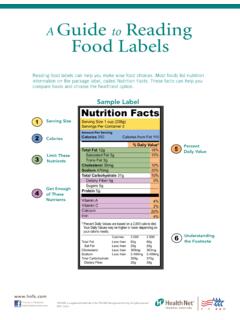Transcription of Home Probation and Parole Officers Speak Out—Caseload …
1 Volume 71 Number 3. home Probation and Parole Officers Speak Out Caseload and Workload Allocation Matthew DeMichele, ( ). University of Kentucky Council of State Governments American Probation & Parole Association Brian K. Payne, Sociology and Criminal Justice Old Dominion University Community Corrections Goals in Practice Methods Findings Goal Ambiguity Concerns about Funding Goal Ambiguity Evidence-Based Practices COMMUNITY CORRECTIONS populations have experienced tremendous growth for the past two decades. The Bureau of Justice Statistics Correctional Survey (http://. htm) reveals that Probation and Parole populations have grown unabated since 1980. This growth has serious implications for Probation and Parole agencies regarding how to make caseload and workload decisions.
2 It is important to consider differences between caseload, which is the number of offenders supervised by an officer, and workload, which is the amount of time needed to complete various tasks. While caseload size will grow as offender populations increase, workload per officer is a more stagnant figure, as there are only so many working hours available in each day, week, month, or year for each officer. These issues related to workload allocation are further complicated by two additional trends in community corrections. Probation was once assigned almost exclusively to relatively low-level offenders who posed little threat to public safety and were mostly in need of pro-social steering (Petersilia, 1998). In an attempt to alleviate jail and prison crowding, however, Probation caseloads are being populated with offenders who potentially pose greater community safety threats.
3 This is a point made by Taxman, Shephardson, and Byrne (2004: 3) in Tools of the Trade, in which they mention that Probation rolls increasingly mirror the prison population.. Taxman and her colleagues add that more than half of probationers today are convicted felons.. These offenders have more criminogenic needs, as they may be gang members, sex offenders, or domestic violence offenders. As a result, these offenders will require more officer time to provide adequate supervision, treatment, and enforcement of conditions, and hopefully behavior change. A second trend facing Probation and Parole agencies is the growth in conditions of supervision. These conditions are often instituted by non-community corrections professionals such as judges, releasing authorities, and legislators.
4 What is often a one- size -fits all decision-making style has the potential to foster rather standard conditions being applied to offenders, with little consideration of individual offender characteristics. For instance, in many jurisdictions, regardless of an offender's substance abuse history, he or she must submit to periodic drug tests. This type of sanction, while perhaps noble in its attempt to prevent drug use, may not be realistic, relevant, or based on research, something Carl Wicklund (2004), Executive Director of the American Probation and Parole Association (APPA), referred to as the three Rs of community supervision. Karol Lucken (1997: 367) points out the potential unanticipated consequences of increased failures due to what she refers to as the piling up of sanctions as they expose offenders to a number of punitive and rehabilitative controls, which often leads to violations and returns to the correctional system.
5 The fact that an external body whether judge or releasing authority has much discretion in establishing supervision conditions may not be problematic in and of itself. It becomes potentially problematic, however, when such decisions are made with little input from presentence investigation reports or risk assessments, and otherwise in isolation from research evidence supporting effective community corrections strategies. The use of research to identify effective programs is not a new idea. Rather, the medical field and several other areas of human services are beginning to see the value in evaluating the effectiveness of specific strategies with certain categories of people to more widely adopt strategies and policies that have been shown to work and to eliminate those that do not work.
6 To date, there is little research offering information from Probation and Parole Officers to assist policymakers and administrators in confronting workload allocation issues. To fill this void, this study considers how Probation and Parole Officers describe concerns related to workloads. Addressing how workers define their workloads provides a framework for understanding how these recent trends of growth in caseloads and standardization of Probation / Parole conditions have altered the Probation / Parole experience for Officers and offenders. back to top Community Corrections Goals in Practice Community corrections agencies work with stakeholders in their jurisdictions to establish clearly defined organizational goals and an overall strategy to achieve, evaluate, and adjust such strategies.
7 These goals are to be jurisdictionally appropriate and therefore rooted in local contextual conditions, not necessarily global national standards. However, it does seem to be generally accepted that Probation and Parole agencies are in the business of community safety through instituting a balanced approach of surveillance, treatment, and enforcement (see Taxman et al., 2004). This tripartite focus is rooted in evidence-based practices that begin with assessing an individual offender's level of risk as an indication of his or her probability to re-offend. Of course, community corrections Officers are not singly responsible for achieving the goal of public safety; rather, Probation and Parole outcomes are embedded in a larger multi-organizational justice system that incorporates law enforcement, institutional corrections, and courts, as well as non-justice agencies including victims of crime, treatment providers, and others.
8 Once Probation and Parole agencies define a locally acceptable goal, it is important to institute a strategy to accomplish their organizational goal. This strategy no doubt involves incorporating the many interested stakeholders involved in the justice system process through in-depth collaboration. Through collaboration and an overall strategy aimed at public safety, former New Jersey Parole Board Chair Mario Paparozzi (2007) suggests that Probation and Parole can own their outcomes. By owning outcomes, Paparozzi is identifying the importance for Probation and Parole administrators to establish clearly defined goals related to public safety and the community, state these goals, and institute policies and practices to achieve such outcomes. Expected outcomes may not always follow.
9 As Paparozzi notes, If I ended up on the 11 o'clock news, you know something went wrong. It is expected that from time to time things will go wrong, offenders will re-offend, there will be highprofile cases receiving much media attention to exploit the faults of Probation or Parole agencies. What is important, however, is for Probation and Parole agencies to work to diminish recidivism by utilizing scientific or state-of-the-art . procedures to bring about offender behavior change (Taxman et al., 2004). Judy Sachwald (2004), Director of Maryland Probation and Parole , promotes a similar argument by incorporating a model of supervision rooted in scientific exploration and knowledge of offender behavior. She suggests that Probation and Parole agencies should do it, tell it, and sell it, with the it referring to shaping policies, operations, and professional development within agencies around scientific principles related to evidence-based practices.
10 There is no doubt that evidence-based practices designed to reduce risk of re-offending are infusing the community corrections field with more scientific approaches. These approaches rely on risk assessments to allow Probation and Parole agencies to differentiate and typologize offenders based upon their relative level of risk to re-offend. This strategy allows for addressing criminogenic needs anti-social behavior, anti-social personality, anti-social values and attitudes, criminal peer groups, substance abuse, and dysfunctional family relations through an integrated approach of surveillance, treatment, and enforcement. Although community corrections Officers have numerous challenges to overcome, there are few issues more central to the organization and function of Probation and Parole practice and success than workload allocation issues.














